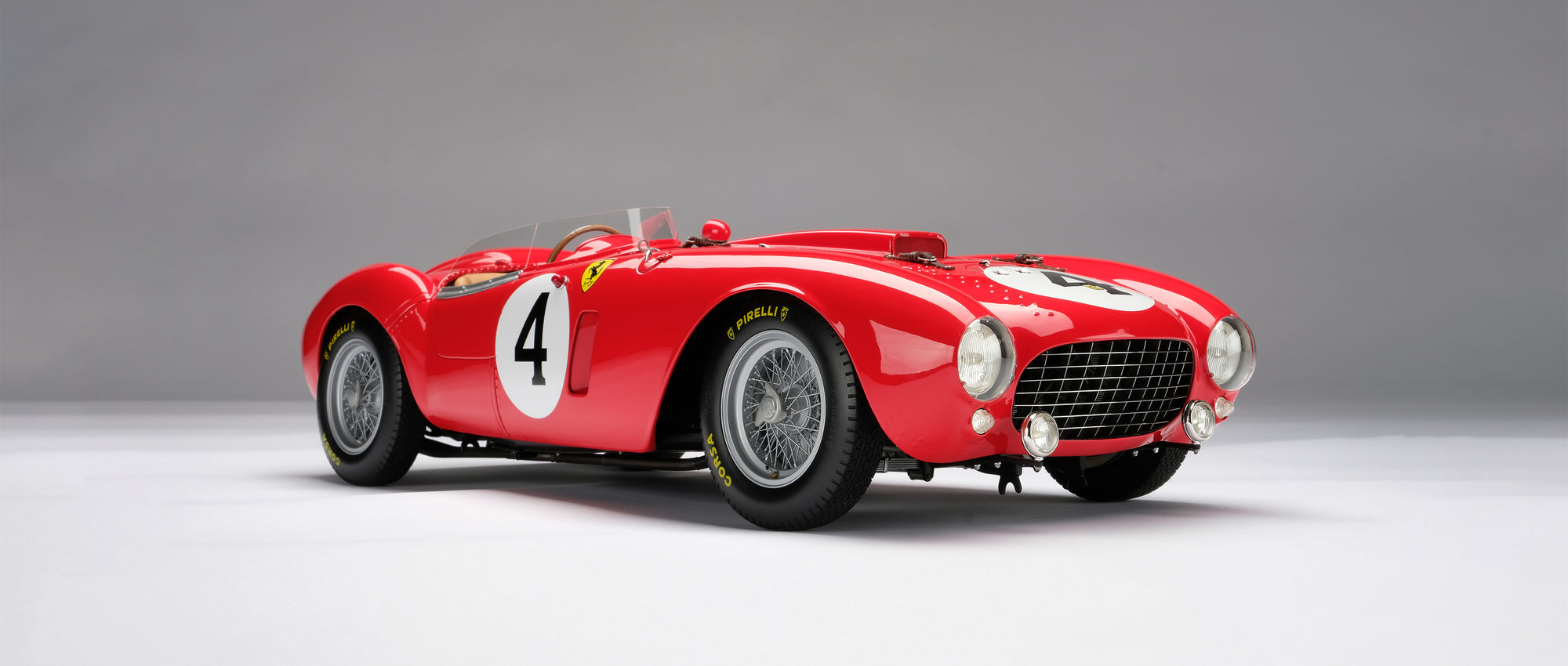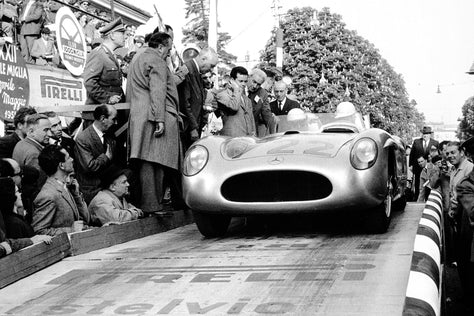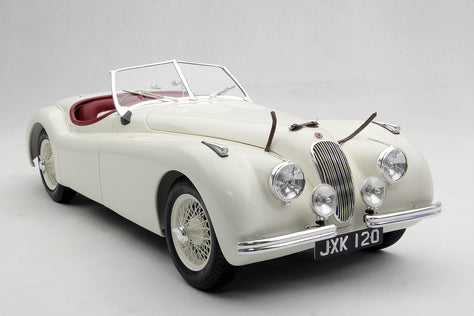Technical Details
- Description
- Scale guide
- Limited Edition of 199 pieces
- As raced to victory by José Froilán González and Maurice Trintignant at the 24 Hours of Le Mans at Circuit de la Sarthe on the 12th and 13th of June 1954
- Each model hand-built and assembled by a small team of craftsmen
- 1:8 scale model, over 56 cms/22 inches long
- Made using the finest quality materials
- Over 4000 hours to develop the model
- Over 400 hours to build each model
- Thousands of precisely engineered parts: castings, photo-etchings and CNC machined metal components
- Original CAD designs created after scans of an original car
- Archive imagery and paint codes supplied by Scuderia Ferrari
- Officially licensed 24 Hours of Le Mans product
One of the most important cars in Ferrari’s illustrious history, the Ferrari 375 Plus was built to extend the success of the 375 MM that powered Ferrari to success in the inaugural FIA World Sportscar Championship in 1953. Facing the threat of being unable to match the sophisticated new 8-cylinder Formula 1 designs from Mercedes-Benz and Lancia, nor even the 6-cylinder 250Fs from Maserati, Enzo Ferrari instead focused his attention upon perfecting a line of large capacity sportscars. The result would become known by the French racing community as 'Le Monstre' and by the British as 'The Fearsome Four-Nine'. The 375 Plus competed and was victorious at the most prestigious international races, earning Ferrari its first works victory at Le Mans and cementing itself into sportscar legend in the process.
Using the 375 MM as a starting point, and the 375 Formula 1 car as inspiration, Aurelio Lampredi developed a truly powerful 4.9 litre V12 engine, rated at nearly 350 horsepower. The engine came with a single spark plug per cylinder configuration with twin magnets and was fed by three Weber-46 DCF/3 carburettors. As a result, the 375 Plus was able to fire up to speeds of around 174mph (280km/h), an incredible feat for a car produced in the 1950s.
Pinin Farina and Carrozzeria Vignale fashioned the aluminium body, which featured flush fenders and a pronounced trunk bulge to accommodate the car’s spare tire and long-distance 190 litre (47.6 gallon) fuel tank. The 375 Plus’s new, strengthened chassis was made from steel tubes and, though it retained the same front suspension as its predecessors, the rear suspension came with a new de Dion axle, twin radius arms with transverse leaf springs and Houdaille shock absorbers. The 375 Plus’s new setup offered improved stability, balance and road handling at higher speeds.
The Ferrari 375 Plus took a stunning win in its debut race at Agadir, Morocco, in the hands of Giuseppe ‘Nino’ Farina in February 1954. Though the same driver and car would retire from the following week’s Dakar GP, they set a record fastest lap before doing so. In April, Umberto Maglioli and Nino Cassani ran a single 375 Plus in the Giro di Sicilia and, after just four hours of racing, held a three-and-a-half-minute lead, before the usually reliable Maglioli overturned the car, ending any hopes of victory. Ferrari entered four cars into the Mille Miglia in May, though sadly no car reached the chequered flag. Maglioli came the closest to victory as he chased down the leading Lancia of Alberto Ascari, before a single split pin fell out, causing the gearbox to stop functioning. This disappointment would only fuel Ferrari as, two weeks later, José Froilán González earned a dominant triumph in the Formula 1-supporting sports car race at Silverstone, leading virtually from start to finish and sensationally lapping the last-placed of the 27 starters three times. The 1954 Le Mans 24-Hour race followed. González, now partnered with Maurice Trintignant, emerged victorious in a heavily weather-affected race. It was a thriller duel with the Jaguar D-Type of Duncan Hamilton and Tony Rolt right to the end, producing the closest finish at Circuit de la Sarthe since 1933: less than 5km (just half a lap). Ultimately, it was Ferrari who would win sports car racing’s most prestigious prize for the second time. The fearsome 'Four-Nines' would not be run again by the Ferrari factory, but a series of entries came from Mexico and the United States for the five-day Carrera Panamericana in Mexico. Maglioli took a dominating victory, 25 minutes ahead of a 375 MM and nearly two hours ahead of a Porsche in third position, ensuring maximum points in the World Sportscar Championship for the Italian marque.
Just five examples were constructed by Ferrari, chassis numbers 0384, 0386, 0392, 0396 and 0398 all with the AM (America) suffix, making the 375 Plus far less common than the revered Ferrari 250 GTO. In June of 2014, 0384 AM sold at a Bonhams Goodwood Festival of Speed auction for £10,753,450 (then $18.3 million), though this particular example had a contested ownership history and was eventually sold in a private settlement after a two year legal case.
This fine 1:8 scale model of the Ferrari 375 Plus is as raced to victory by José Froilán González and Maurice Trintignant at the 24 Hours of Le Mans at Circuit de la Sarthe on the 12th and 13th of June 1954. The race was a heavily rain-affected thriller, viewed by many as a battle between brute force and science: the Ferrari 375 Plus up against the new 3.4-litre Jaguar D-Type with its sleek, aerodynamic bodywork. Jaguar brought D-Types straight from the factory, so fresh that they had yet to be painted when they arrived. The British team kept the majority of their 1953 driver line up: previous winners Tony Rolt & Duncan Hamilton, second placed Stirling Moss and Peter Walker, and Peter Whitehead, this year paired with F1 driver Ken Wharton. Ferrari still fielded a team of top drivers, despite the absence of Ascari, Farina and Hawthorn: Umberto Maglioli, José Froilán González and Maurice Trintignant were in the current Ferrari F1 works team; with them were Paolo Marzotto, ex-Gordini driver Robert Manzon and Louis Rosier.
In practice, the Ferrari and Jaguars were a class above the rest of the field. The Jaguars were showing an advantage in handling, brakes and top speed, but Ferrari had the superior power and acceleration. The race started under dark clouds, and the Ferraris raced into an early lead. After five laps, the first downpour arrived, negating the Ferrari’s power advantage. Within the hour, the gap between the front runners and the rest of the pack was already an entire lap. The Jaguars fought back in the heavy rain however, Moss taking the lead on lap 22. Wharton’s D-Type was held up early on with a blocked fuel filter and, over the next couple of hours, the Jaguars suffered engine misfires, allowing the Ferraris to build their lead once again. The rain eased off as the night arrived, which permitted the Jaguars to haul themselves back into contention, as the lead Ferraris suffered their first casualty: the Maglioli/Marzotto car retiring with a broken transmission just after 11pm. The rain returned and caused issues for the British team, Wharton/Whitehead suffered fuel-line issues before withdrawing with transmission problems of their own. The duo joined Moss and Walker’s D-Type in retirement, which had suffered total brake failure at 160mph at the end of the Mulsanne straight. It took two miles of escape road for the car to roll to a stop. Rolt and Hamilton, in the remaining D-Type, moved into second position and set about chasing the leading Ferrari of González and Trintignant. The Rosier/Manzon Ferrari was still running in third until dawn arrived, when the car’s gearbox jammed in second gear, forcing its retirement. With nine hours remaining, the great rivals only had one car apiece and, as the clouds built up and rain became an ever-present threat, the prospects for the aerodynamic D-Type were starting to look promising.
González and Trintignant could afford to take things cautiously, but any delays would empower the chasing Jaguar. Exactly as they feared, the Ferrari hesitated when restarting during a routine fuel stop, encouraging the Jaguar team. The gap reduced to just three minutes, though, in his haste, Rolt glanced the bank coming out of Arnage lapping a slower car, and two minutes were lost in the pits for a bout of improvised panel beating. With ninety minutes to run, Trintignant was maintaining a two-lap lead, and brought the Ferrari in for a routine stop. González took over, but the V12 refused to restart. Ferrari lost seven minutes as the mechanics desperately worked on the engine, before discovering that the rain had saturated the ignition wiring. Rolt was frantically waved on by his pit crew while the Ferrari was stationary, and by the time González was back out on track he was only three minutes ahead. With thunder and lightning now lashing the circuit and visibility at a minimum, Rolt pitted and handed over to Hamilton for the final assault on the Ferrari lead. After some extraordinary times in the awful conditions, the lead was cut to just 90 seconds. González was exhausted as he had not eaten or slept through the weekend, but his pit crew urged him on. As the track dried out, he was once more able to put down the Ferrari’s power and he reached the chequered flag to win the 24 Hours of Le Mans by just under three minutes, which was around half a lap (roughly less than 5km), the closest finish for the race since 1933.
The Argentinian winner had cemented his special place in Ferrari history: three years earlier, he had scored Ferrari's first F1 victory and now, in his last appearance at La Sarthe, he also gave the Scuderia their first works victory at Le Mans. This model has been handcrafted and finished in our workshops with the co-operation and assistance of Ferrari regarding original finishes, materials, archive imagery and drawings. The use of supremely accurate digital scanning of the original car has allowed us to perfectly recreate every detail at scale. Furthermore, it has undergone detailed scrutiny by both engineering and design teams to ensure complete accuracy of representation.
The Ferrari 375 Plus as raced at the 1954 Le Mans 24 Hours is limited to 199 pieces at 1:8 scale.
Pre-order
Bespoke
In order for us to create your bespoke model, you will need to choose 4 extra options. Paint colour, interior colour, wheel style and caliper colour.
Please complete the form and a member of our Sales Team will contact you.
Contact Us
Please contact us for more information about ordering this model.






